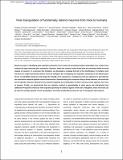Viral manipulation of functionally distinct interneurons in mice, non-human primates and humans
Author(s)
Vormstein-Schneider, Douglas; Lin, Jessica D.; Pelkey, Kenneth A.; Chittajallu, Ramesh; Guo, Baolin; Arias-Garcia, Mario A.; Allaway, Kathryn; Sakopoulos, Sofia; Schneider, Gates; Stevenson, Olivia; Vergara, Josselyn; Sharma, Jitendra; Zhang, Qiangge; Franken, Tom P.; Smith, Jared; Ibrahim, Leena A.; M astro, Kevin J.; Sabri, Ehsan; Huang, Shuhan; Favuzzi, Emilia; Burbridge, Timothy; Xu, Qing; Guo, Lihua; Vogel, Ian; Sanchez, Vanessa; Saldi, Giuseppe A.; Gorissen, Bram L.; Yuan, Xiaoqing; Zaghloul, Kareem A.; Devinsky, Orrin; Sabatini, Bernardo L.; Batista-Brito, Renata; Reynolds, John; Feng, Guoping; Fu, Zhanyan; McBain, Chris J.; Fishell, Gord; Dimidschstein, Jordane; ... Show more Show less
DownloadSubmitted version (35.24Mb)
Publisher Policy
Publisher Policy
Article is made available in accordance with the publisher's policy and may be subject to US copyright law. Please refer to the publisher's site for terms of use.
Terms of use
Metadata
Show full item recordAbstract
© 2020, The Author(s), under exclusive licence to Springer Nature America, Inc. Recent success in identifying gene-regulatory elements in the context of recombinant adeno-associated virus vectors has enabled cell-type-restricted gene expression. However, within the cerebral cortex these tools are largely limited to broad classes of neurons. To overcome this limitation, we developed a strategy that led to the identification of multiple new enhancers to target functionally distinct neuronal subtypes. By investigating the regulatory landscape of the disease gene Scn1a, we discovered enhancers selective for parvalbumin (PV) and vasoactive intestinal peptide-expressing interneurons. Demonstrating the functional utility of these elements, we show that the PV-specific enhancer allowed for the selective targeting and manipulation of these neurons across vertebrate species, including humans. Finally, we demonstrate that our selection method is generalizable and characterizes additional PV-specific enhancers with exquisite specificity within distinct brain regions. Altogether, these viral tools can be used for cell-type-specific circuit manipulation and hold considerable promise for use in therapeutic interventions.
Date issued
2020-08Department
McGovern Institute for Brain Research at MITJournal
Nature Neuroscience
Publisher
Springer Science and Business Media LLC
ISSN
1097-6256
1546-1726